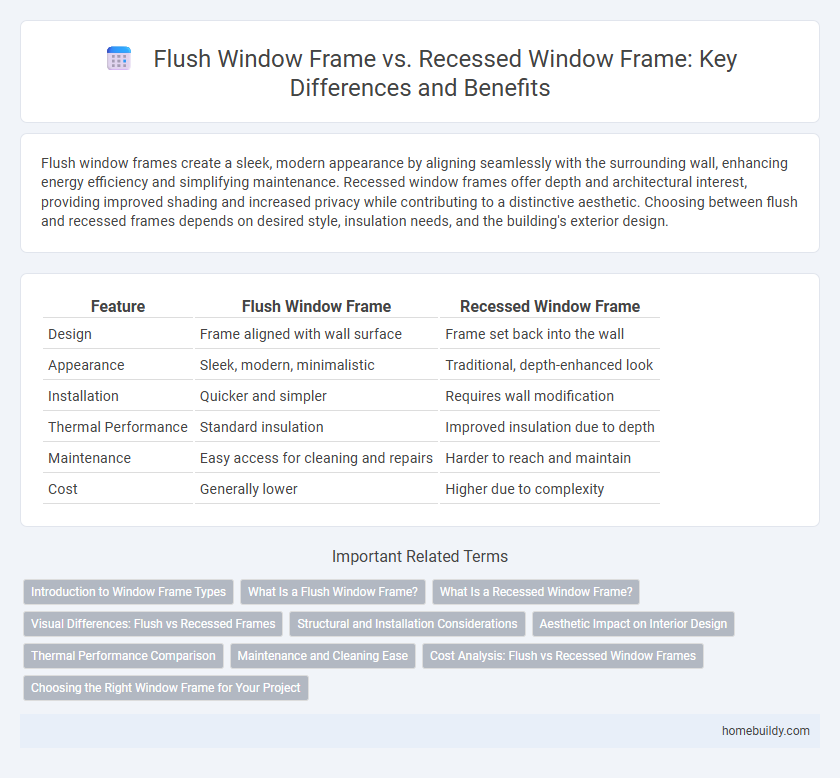Flush window frames create a sleek, modern appearance by aligning seamlessly with the surrounding wall, enhancing energy efficiency and simplifying maintenance. Recessed window frames offer depth and architectural interest, providing improved shading and increased privacy while contributing to a distinctive aesthetic. Choosing between flush and recessed frames depends on desired style, insulation needs, and the building's exterior design.
Table of Comparison
| Feature | Flush Window Frame | Recessed Window Frame |
|---|---|---|
| Design | Frame aligned with wall surface | Frame set back into the wall |
| Appearance | Sleek, modern, minimalistic | Traditional, depth-enhanced look |
| Installation | Quicker and simpler | Requires wall modification |
| Thermal Performance | Standard insulation | Improved insulation due to depth |
| Maintenance | Easy access for cleaning and repairs | Harder to reach and maintain |
| Cost | Generally lower | Higher due to complexity |
Introduction to Window Frame Types
Flush window frames align evenly with the exterior wall, creating a seamless and modern appearance that enhances energy efficiency by minimizing air gaps. Recessed window frames are set back from the wall surface, offering increased depth and shadow lines that add architectural interest while improving durability against weather exposure. Both types play crucial roles in framing design, impacting thermal performance, aesthetics, and installation methods.
What Is a Flush Window Frame?
A flush window frame is designed to align seamlessly with the exterior wall, creating a smooth and modern appearance without any protruding elements. This type of frame enhances thermal efficiency by minimizing gaps that could cause air leakage and provides a sleek aesthetic that integrates well with contemporary architectural styles. Unlike recessed window frames, flush frames sit directly in line with the facade, which can simplify cleaning and maintenance.
What Is a Recessed Window Frame?
A recessed window frame is installed deeper into the wall, creating a flush surface between the window and the exterior facade, enhancing architectural depth and shadow effects. This type of frame improves thermal insulation by allowing thicker wall layers around the window, contributing to energy efficiency. Recessed frames also offer better protection against weather elements compared to flush window frames, minimizing water infiltration and increasing durability.
Visual Differences: Flush vs Recessed Frames
Flush window frames align seamlessly with the exterior wall surface, creating a sleek and modern appearance that minimizes shadows and visual interruptions. Recessed window frames are set back from the wall plane, producing depth and architectural interest through pronounced shadow lines and a more traditional aesthetic. The choice between flush and recessed frames significantly impacts the building's facade, influencing both light reflection and overall design coherence.
Structural and Installation Considerations
Flush window frames offer a sleek, minimalist appearance by aligning with the exterior wall surface, requiring precise measurements and tight sealing during installation to prevent air and water infiltration. Recessed window frames are set deeper within the wall cavity, enhancing thermal insulation and providing improved protection against weather elements, but demand careful structural assessment to ensure adequate support and water drainage. Both types necessitate compatibility with wall construction materials and professional installation to maintain structural integrity and durability.
Aesthetic Impact on Interior Design
Flush window frames create a sleek, minimalist look by aligning seamlessly with the wall surface, enhancing clean lines and modern aesthetics in interior design. Recessed window frames introduce depth and shadow, adding architectural interest and a sense of dimension that complements traditional or eclectic styles. The choice between flush and recessed frames significantly influences the overall ambiance, balancing flat elegance with textured complexity in interior spaces.
Thermal Performance Comparison
Flush window frames provide improved thermal performance by minimizing air leakage and maintaining a consistent barrier against external temperatures, which reduces energy loss. Recessed window frames, while offering aesthetic depth, often create gaps that can lead to higher thermal bridging and decreased insulation efficiency. Modern flush window designs incorporate advanced materials and seals specifically engineered to enhance thermal resistance and limit heat transfer compared to traditional recessed frames.
Maintenance and Cleaning Ease
Flush window frames offer a smooth, continuous surface that prevents dirt buildup, making maintenance and cleaning straightforward with minimal effort. Recessed window frames, featuring indented sections, tend to accumulate dust and debris in crevices, requiring more frequent and detailed cleaning to maintain their appearance. Choosing flush window frames enhances ease of upkeep, especially in environments prone to dust or pollution.
Cost Analysis: Flush vs Recessed Window Frames
Flush window frames typically cost more upfront due to higher material quality and precision installation requirements, whereas recessed window frames offer cost savings through simpler construction and reduced labor. Long-term maintenance expenses are often lower for flush frames because of their streamlined design, minimizing dirt accumulation and weather exposure. Budget-conscious projects benefit from recessed frames' affordability, but flush frames provide enhanced durability and aesthetic value justifying their initial premium.
Choosing the Right Window Frame for Your Project
Flush window frames offer a sleek, modern appearance by aligning seamlessly with the wall surface, enhancing minimalistic design aesthetics and improving weather resistance. Recessed window frames provide added depth and shadow lines, creating architectural interest and allowing for greater customization with trim and finishes. Selecting the right window frame depends on factors such as desired style, insulation performance, and the building's structural requirements.
flush window frame vs recessed window frame Infographic

 homebuildy.com
homebuildy.com